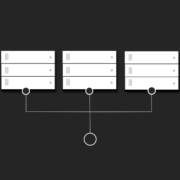
GitLab Outage vs. Continuous Code Development
GitLab provides developers with tools and features tailored to their needs. This Git platform is widely considered to be suitable for the continuous delivery process. Flexible deployments possibilities, DORA metrics, and multi-cloud deployment are just some of the reasons. GitLab is not an unintelligible choice if your company is rooted in DevOps culture. But if you want to ensure long-term success there is one major problem that needs to be addressed – the GitLab outage. In this article, we will introduce you to the concept of Disaster Recovery in the GitLab context and put in perspective some issues that your company could encounter in the future.
What is GitLab
Essentially GitLab is a single application that serves as a DevOps Platform – an open-source, web service Git repository that offers open and private repos, as well as issue tracking. It allows developers to handle all aspects of a project, from project planning to source code management and security. It also enables teams to interact and deliver better quality software. It supports teams in increasing productivity, resulting in higher customer value. You may set and change people’s permissions in GitLab based on their responsibilities.
Continuous code development
Continuous code development covers multiple characteristics, such as continuous integration, continuous delivery/deployment, and last but not least continuous testing. Continuous integration (CI) is a term that has grown over time and refers to the practice of integrating new code commits to source code regularly. Continuous delivery (CD) is built on CI – each code commit is tested automatically at the moment it is introduced.
Ready to safely store code in GitLab? Do the next best thing and secure it with the first professional GitLab backup.
Manual testing is added to the CD approach via continuous testing. The test group will test the most up-to-date version of accessible code via continuous testing. To enable this process to run as smoothly as possible, you should plan to avoid costly mistakes. Sometimes, and we don’t wish this upon you, you may come across inevitable crises, such as GitLab Outage.
GitLab Outage
On the GitLab Status site, we can check the current GitLab status as well as scroll through status history. On the list, there are many events visible, including Degraded Performance, Partial Service Disruption, and Planned Maintenance. All of them can disrupt a company’s continuous code development and are pretty common.
One of the biggest GitLab outages occurred in 2017 and lasted for six hours. It happened because of human error – the unintentional deletion of data from major database servers. Unfortunately, GitLab erased some production data and was unable to retrieve it in the end. Database and data modifications, including projects, comments, user accounts, issues, and snippets were lost.
GitLab Shared Responsibility Model
At this point, it is important to mention the shared responsibility model because it has an impact on any disasters that take place on the GitLab platform. GitLab uses shared responsibility models to determine which security responsibilities belong to the service provider and which belong to your company. In a nutshell, service providers are in charge of the accessibility, security, and availability of the entire system. However, they are merely data processors when it comes to data; as the owner, you are responsible for ensuring that your data is adequately safeguarded and in compliance with all legal obligations, such as data retention.
In most technology-related organizations, source code is the most valuable intellectual property. Your company is solely responsible for the appropriate handling of your account’s data.
Disaster Recovery with GitProtect.io backup
The ability of an organization to respond to and recover from a disaster that harms business operations is known as disaster recovery (DR). The goal of disaster recovery techniques is to enable an organization to rapidly recover access to critical systems and IT infrastructure in a crisis.
A backup plan delivered by GitProtect allows you to simply and efficiently manage the security of your GitLab projects. It takes about 5 minutes to set up. You have the option of using a predetermined backup plan or creating your own.
You can choose the following criteria for such a backup plan:
- Which data needs to be protected: for example, all data, only chosen GitLab repositories and metadata.
- On which storage you are going to keep your backup copies: our secure cloud, a local one, NAS devices, AWS, Wasabi Cloud, or any other S3 compatible storage.
- Select the backup execution frequency in monthly, weekly, daily, and hourly increments. You may schedule backups during non-working hours so that they don’t interfere with your work or network capacity.
- Set advanced features: retention, versioning, rotation schemes, and many more.
To ensure quick Disaster Recovery and prevent downtime, GitProtect allows you to restore all repositories with metadata to the same or alternative version control hosting platform. All repositories can be recovered in a single operation. You may choose whether to recover records with or without metadata.
Backup strategy
To prepare for gaps in continuous code development, the company needs to come up with a sufficient backup strategy. First, you must specify the two most crucial parameters: Recovery Point Objective (RPO) and Recovery Time Objective (RTO). The highest volume of data that may be lost following a recovery from a disaster, failure, or equivalent event before data loss exceeds what is acceptable to a business is described as RPO. RTO refers to the amount of time and service level required to restore a business process following a disaster to prevent the unacceptably negative effects of a loss of continuity.
GitProtect for GitLab provides a comprehensive set of data recovery tools. It’s adaptable, with point-in-time recovery to any location – whether a local device or a remote repository is preferred.
Summary
GitLab as a hosting service has shown to be a very solid option, but it is not without flaws. It is widely recommended to use third-party backup software. Please keep in mind that your source code, projects, Intellectual Property, hours of labor, and thousands of dollars are on the line. As the most professional backup software, GitProtect appears to be a little investment for the peace of mind it delivers. Every company’s disaster recovery and business continuity strategy should include a backup strategy suited for their needs.








